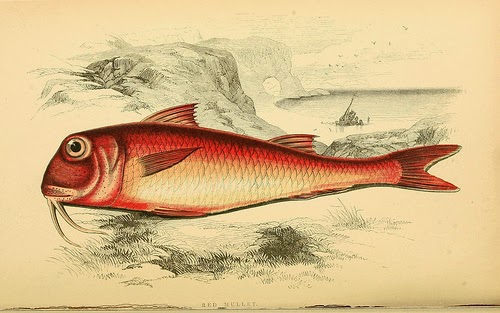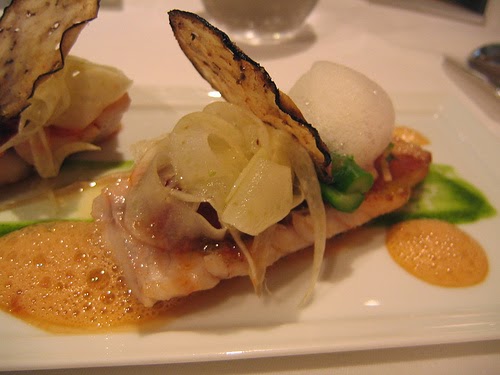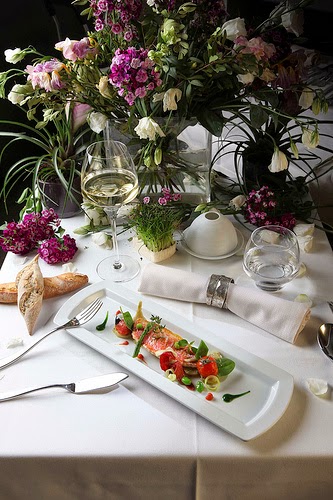The
central canal and port in Sète.
www.flickr.com/photos/psc49/43106980831/
For the visitor, Sète is an attractive and walkable town, and with its canals, it is also called the Venice of Languedoc. Sète's cuisine includes Provencal and Italian input along with local creations. (Since 1-1-2016 the region of Languedoc-Roussillon is part of the new super-region of Occitanie).
Sète and the Thau Basin.
Sète is also called the capital of the Bassin or Étang de Thau. This inland basin, sometimes called a lake, which it is not, is a gigantic center for fishing and the fish and seafood farming industry; it runs inland parallel to the Mediterranean coast. Nearly all of the fish and seafood on Sète’s restaurant tables come from this basin or Sète's ocean-going fishermen and women. The Thau Basin is twenty km (13 miles) long and 3 km (2 miles) wide. On the Mediterranean side of the basin are fabulous beaches, and around the basin are striking fishing villages and others that are now centers for water sports; just a little to the North is the Languedoc wine country. All along this part of the Mediterranean coast are similar but smaller basins.
Map of
the Thau Basin.
Copyright
Google Maps 2014.
What to eat in Sète.
There is probably a Sétoise version or a Sétoise recipe for every fish and seafood dish in the south of France. Wandering around the town I have seen menus offering Sétoise versions of Bouillabaisse and Sétoise takes on other Provencal dishes. More importantly, during my two and a half-day sojourn, I did not receive one meal or even a snack that was below excellent.
Sète
port and city.
www.flickr.com/photos/hirondellecanada/3026004481/
From talking to locals and the servers in restaurants, it is clear that most local dishes either came with Italian immigrants or are Italian tweaks to local dishes. More about the Italian influence later.
Sétoise specialties on Sète restaurant menus:
Bourride de Lotte à la Sètoise - Bourride de Lotte is a traditional Provencal monkfish stew, and monkfish are one of the tastiest sea fish with a very firm texture. Sète’s Bourride is a creamy stew of monkfish and vegetables all flavored with white wine and aioli, the garlicky mayonnaise of the south of France. The stew is served with more aioli on the side.
Getting
the fish soup ready in Sète
www.flickr.com/photos/hirondellecanada/3164858800/
La Teille Sétoise – A traditional poulpe, octopus, pie claimed as their own by the residents of Sète with Italian heritage. The original octopus pie is now also made with calmar, squid, or seiche, cuttlefish. Whether the pie is made with octopus or its surrogates, it will be seafood in a pie with tomatoes and onions all flavored with garlic and rosemary. This is a traditional Sétoise street food that has now made it to the big time and is on many restaurant menus. In restaurants, the pie is served as entrée, the French starter, with individual pies often accompanied by a small green salad.
Les Encornets Farcis à la Sétoise – Small squid stuffed in the manner of Sète. Setoise stuffing always includes pork sausage meat, sometimes with added veal, along with breadcrumbs and tomatoes. The flavoring comes from spicy peppers, usually the Piment d’Espelette, garlic, dry white wine, sometimes Cognac and flavoring from the herb group the Herbs of Provence. The dish may also be made with Sète’s beloved aioli in the recipe or served on the side.
Moules Farcies à la Sétoise – Mussels, from the Thau Basin, stuffed in the manner of Sète. The mussels are stuffed with sausage meat and cooked in white wine and tomato puree. The mussels will be served with the ever-present aioli on top.
Mussels
www.flickr.com/photos/myhsu/4933764329/
Macaronade à la Sétoise - Macaronade in the manner of Sète. The Sète Macaronade is made with beef, not macaroni. Sometimes Sétoise Macronades come with versions of Italian brajoles, which are stuffed meat rolls, bacon, tomatoes, and onions; all flavored with red wine, parsley, and paprika. To accompany the dish will be grated Parmesan or Gruyere cheese.
Apart from a Macronade de bœuf or a Macaronade à la Sétoise elsewhere in France, other macronades will, as the name suggests, be dishes made with macaroni; when it is not clear ask.
Soupe de Poisson de Roche à la Sétoise - A fish soup favorite all along France’s Méditerranéen coast. The Sétoise version is made with small fish that are caught in, or near, the criques, creeks, along the coast of Sète. The soup is flavored with garlic, and aioli, and served with an aioli-spiced rouille sauce on the side. Rouille is traditionally a thick sauce served in and alongside most fish soups in the South of France. They have many different tastes; in Sète the accent is on the aioli.
NB The dish called Rouille à la Sétoise is not a sauce, rather it is a stew of cuttlefish.
The fish
market in Sète
www.flickr.com/photos/hirondellecanada/3160563815/
The wines from around Sète
The wines of the Coteaux du Languedoc cover a vast area, and it is one of the largest appellations in France. From the Coteaux du Languedoc came the wines that I chose for my fish and seafood dishes. The wines I chose I had not seen elsewhere, and I enjoy trying different wines in new places; with the occasional exception, local wines make an enjoyable change.
Picpoul
de Pinet.
www.flickr.com/photos/farehamwine/12519038624/
The first wine I selected was a Coteaux du Languedoc Picpoul-de-Pinet AOC/AOP. It is a white wine from the area around the town of Castelnau-de-Guers, just 21 km (14 miles) from Sète. I knew nothing about this wine and chose it for its intriguing name, Picpoul-de-Pinet; I did not regret my choice, it was fruity and dry white. If I had not had a problem with that 20 kilo limit on flights, I would have taken a case home.
The second wine was a white Coteaux du Languedoc Mas-Jullien AOP. It was an excellent dry white that went perfectly with the highly flavored fish dishes of Sète.
Traveling to Sète by road and rail.
Sète is on the Mediterranean coast in the department of Hérault in the region of Occitanie. It is 31 km (19 miles) from Montpellier, the regional capital, 20 minutes by train and 40 minutes by car. For those who may be traveling along the Mediterranean Coast, Sète is two hours and a quarter-hours by car from Marseilles, 2 hours by train. In the opposite direction from Sete to Perpignan, it is 143 km (89 miles) by road, one and a half hours by car or train. From Perpignan to the Spanish border is another 29 km (18 miles).
How to get to Sète by air.
The nearest major airport is the Beziers airport 35 km (22 miles) away, followed by the larger Montpelier airport which is 45 km (28 miles) away. From the airport of Bezier and/or Montpelier you will need the bus or taxi connections to the train station in town. The trains from Beziers and/or Montpelier to Sete are just about once every hour and the traveling time, once you are on the train, is less than twenty minutes.
A short history of Sète.
The incredibly active Jean-Baptiste Colbert, Louis XIV’s Prime Minister, decided to build a canal that would join the Atlantic, at Bordeaux, to the Mediterranean. Sète would be built at the canal's exit to the Mediterranean as a large fishing port and an inland port. In the 17th century, the canal saved four weeks of sailing around Spain to the north of France, and the occasional battles with pirates from North Africa. Good roads connecting France from North to South hardly existed, and in winter whatever there was became impassable. At the time, there was an island called Cette just off the mainland, and in creating the largest fishing port in the Mediterranean, the island was joined to the mainland. Today you would not realize that part of the town is an island, but having the fishing port in the center of town makes walking around a unique experience. The town itself has many canals, after all, it is called the Venice of Languedoc, so when visiting Sète take a motorboat tour of the canals; alas they have no gondolas. Before it was joined to the mainland the island’s first known name was given 2,500 years ago when the Greeks came and called it Ketos. Later it would become Ceta, Seta, Cetia, and Cette, and finally, in 1928, the city became Sète.
The canal, which opened in 1681, allowed the whole region to export goods to Paris and the North of France, and of the greatest importance was wheat. Today the canal is no longer used for trade, but you can rent a motorboat with full sleeping and cooking equipment, showers, toilets, air-conditioning, and more. Then, on your own, with one hour's instruction, you may sail from Sète to Bordeaux on the Atlantic. If you prefer you may sail in the opposite direction from Sete along the Canal du Rhone inland, close to the Mediterranean, to the town of Aigues Mortes and then up to Beaucaire, just 25 km (16 miles) below Avignon. These motorboats allow you to stop and get out and tour or dine whenever the thought arises.
The Italian Influence.
Linked to the building of the fishing port and the canal were many Italian craftsmen and workers who afterward stayed to put their imprint on the city and its cuisine. Today in Sète you will meet many people with Italian surnames, a reminder that the original workforce included many Italians. They together with more Italian immigrants who came in the 1800’s, makes for a French city where half of the population has Italian heritage. Along with the Italians came many French Catalans and then later came immigrants from Morocco and Algeria. Today the port of Sète has ferries to Italy including Sicily and Sardinia, Spain including the Balearic Islands and Morocco.
Sète is much more than just a city with excellent restaurants, canals and a pleasant place to walk around; it also provides entertainment for its residents and tourists. In the summer, apart from concerts and celebrations of all kinds from June through September you may watch the Sète joutes. Joutes are jousts, but without knights riding against each other on horseback; instead, here the jousting knights are Sète fishermen and women and other locals. For the joust, there are two boats, each with ten rowers who pull to meet each other as fast as they can. On each boat is a high platform with a jouster holding a lance and a shield. When they meet, the winner will have knocked his opponent into the sea! If you are in the area in the summer call the Tourist Information Office and find the exact days and times when they are holding their joutes. They are held on nearly every weekend and once or twice a week during the summer months. See the English language website of the Sète Tourist Information Office:
Sea jousts in Sète.
Just outside of Sète
After visiting Sète, there is still much to see outside the town; Sète is on the edge of the beautiful Étang de Thau, and on its own that is reason enough to visit the area. For more about the Étang de Thau, the Thau basin, look at the English language website of the town of Marseillan which is in the north of the Thau Basin:
http://www.marseillan.com/english/index.asp
Behind the French Menu
--------------------------------
Behind the French Menu
by
Bryan G. Newman
behindthefrenchmenu@gmail.com
Copyright 2010, 2014, 2018. 2020
--------------------------------
Searching for the meaning of words, names or phrases
on
French menus?
Just add
the word, words, or phrase that you are searching for to the words "Behind
the French Menu" (best when including the inverted commas), and search with
Google, Bing, or another browser. Behind the French Menu’s links,
include hundreds of words, names, and phrases that are seen on French menus.
There are over 450 articles that include over 4,000 French dishes with English
translations and explanations.















